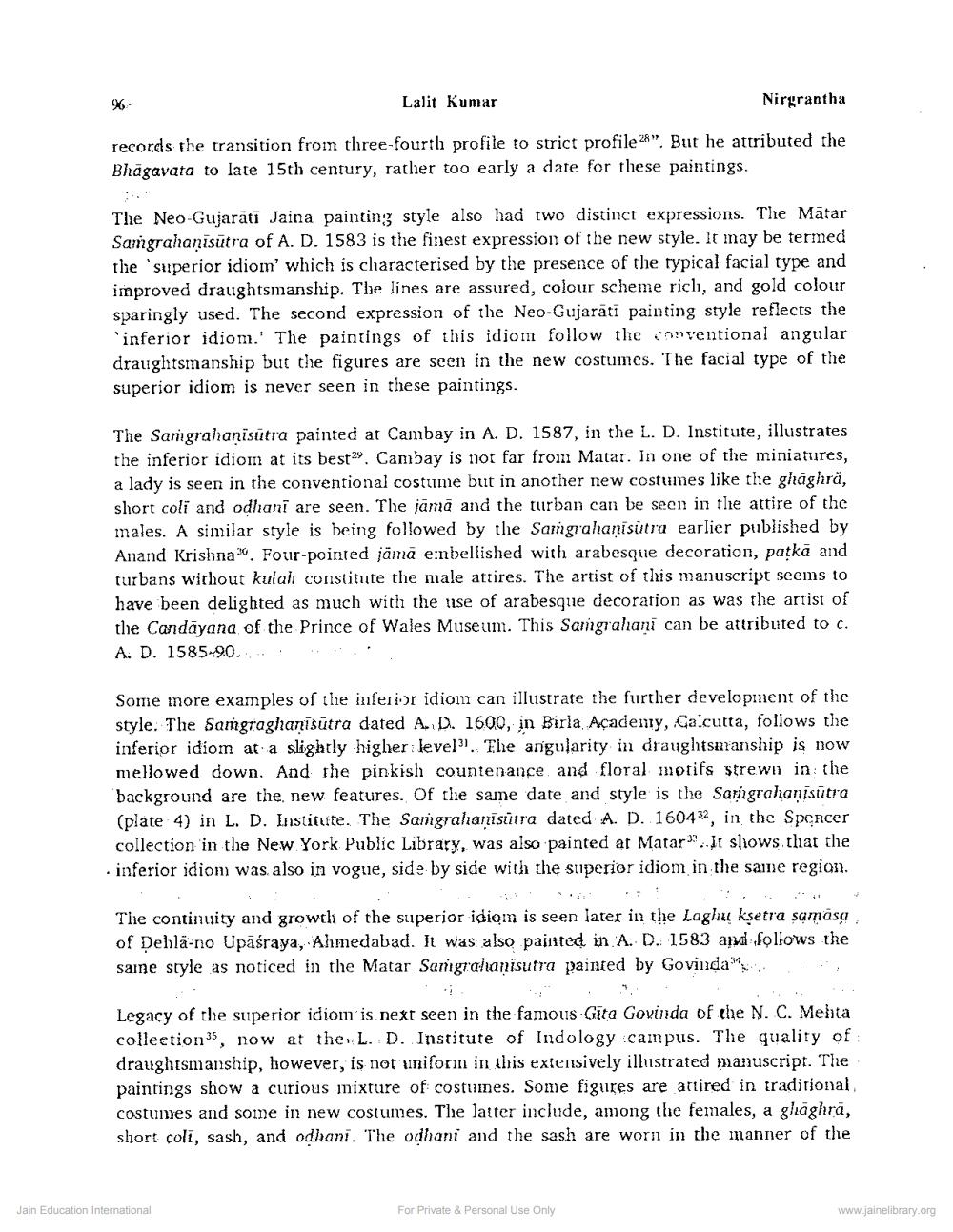Book Title: Gujarati Painting of 16th 17th Century Author(s): Lalit Kumar Publisher: Z_Nirgrantha_1_022701.pdf and Nirgrantha_2_022702.pdf and Nirgrantha_3_022703.pdf View full book textPage 5
________________ 96 Lalit Kumar records the transition from three-fourth profile to strict profile". But he attributed the Bhagavata to late 15th century, rather too early a date for these paintings. Nirgrantha The Neo Gujarati Jaina painting style also had two distinct expressions. The Mätar Samgrahaṇisutra of A. D. 1583 is the finest expression of the new style. It may be termed the superior idiom' which is characterised by the presence of the typical facial type and improved draughtsmanship. The lines are assured, colour scheme rich, and gold colour sparingly used. The second expression of the Neo-Gujarati painting style reflects the 'inferior idiom. The paintings of this idiom follow the conventional angular draughtsmanship but the figures are seen in the new costumes. The facial type of the superior idiom is never seen in these paintings. The Samgrahanisütra painted at Cambay in A. D. 1587, in the L. D. Institute, illustrates the inferior idiom at its best2". Cambay is not far from Matar. In one of the miniatures, a lady is seen in the conventional costume but in another new costumes like the ghaghrä, short coli and oḍhani are seen. The jama and the turban can be seen in the attire of the males. A similar style is being followed by the Samgrahanisütra earlier published by Anand Krishna". Four-pointed jämä embellished with arabesque decoration, patka and turbans without kulah constitute the male attires. The artist of this manuscript seems to have been delighted as much with the use of arabesque decoration as was the artist of the Candayana of the Prince of Wales Museum. This Samgrahani can be attributed to c. A. D. 1585-90. Some more examples of the inferior idiom can illustrate the further development of the style. The Samgroghanisütra dated A. D. 1600, in Birla Academy, Calcutta, follows the inferior idiom at a slightly higher level. The angularity in draughtsmanship is now mellowed down. And the pinkish countenance and floral motifs strewn in the background are the, new features. Of the same date and style is the Sanigrahanisūtra (plate 4) in L. D. Institute. The Sangrahianisitra dated A. D. 1604, in the Spencer collection in the New York Public Library, was also painted at Matar. It shows that the . inferior idiom was also in vogue, side by side with the superior idiom in the same region. The continuity and growth of the superior idiom is seen later in the Lagla kṣetra samasa of Dehla-no Upäśraya, Ahmedabad. It was also painted in A. D. 1583 and follows the same style as noticed in the Matar Sangrahanisütra painted by Govinda Jain Education International Legacy of the superior idiom is next seen in the famous Gita Govinda of the N. C. Mehta collection, now at the L. D. Institute of Indology campus. The quality of draughtsmanship, however, is not uniform in this extensively illustrated manuscript. The paintings show a curious mixture of costumes. Some figures are attired in traditional, costumes and some in new costumes. The latter include, among the females, a ghaghra, short coli, sash, and odhani. The odhani and the sash are worn in the manner of the For Private & Personal Use Only www.jainelibrary.orgPage Navigation
1 ... 3 4 5 6 7 8 9 10 11 12 13 14 15 16 17 18
